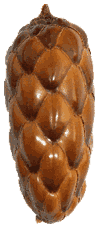 |
Palm |
 |
Palm |
Dypsis eriostachys is restricted to hill forest on the isolated hill, Vatovavy, in the coastal plain of eastern Madagascar near to Mananjary. It occurs on gentle slopes at an elevation of approximately 450 m above sea level. There are estimated to be less than 50 individuals.
It is a diminutive palm of the forest undergrowth, with solitary stems to 1.5 m tall and ca. 1.3–1.7 cm in diameter. There are about 10 leaves in the crown; the leaf sheaths are about 8 cm long and densely covered in red-brown hairs; there is a very short petiole. The leaf blade is forked but otherwise not divided into leaflets and is approximately 30–40 cm long. The short inflorescence is borne between the leaves and is highly branched with dense silvery hairs with darker bases. The fruit is ellipsoid, cherry red, and the endosperm is homogeneous.
Little is known about the natural history of the species.
The forests of Vatovavy have been eroded by shifting cultivation at lower elevations. Because of the rich and diverse palm flora and its easy accessibility to a main road, Vatovavy has become a target for palm enthusiasts and seed collectors. Although there is no direct evidence of seed collecting, it seems very probable that seeds are removed from the site.
There are no formal current conservation measures. However, Vatovavy receives some protection from local people through customary beliefs. If the hill can be formally designated as a protected area, then the prospects for this little palm will be much improved.
A demographic study of the palm should be performed, and it should also be searched for elsewhere on nearby hills.
Dr. John Dransfield, Herbarium, Royal Botanic Gardens Kew, Richmond, Surrey, TW9 3AE, UK (j.dransfield@kew.org)
Dransfield, J. & Beentje, H. 1995.
Palms of Madagascar.
Royal Botanic Gardens, Kew.
Dransfield, J, H. Beentje, A. Britt, T. Ranarivelo & J. Razafitsalama. 2006.
Field Guide to the Palms of Madagascar.
Kew Publishing, Royal Botanic Gardens, Kew.
Dransfield, J, H. Beentje, A. Britt, T. Ranarivelo & J. Razafitsalama. 2006.
Torolalan’ireo Satrapotsy (Palmier) eto Madagasasikara.
Kew Publishing, Royal Botanic Gardens, Kew.